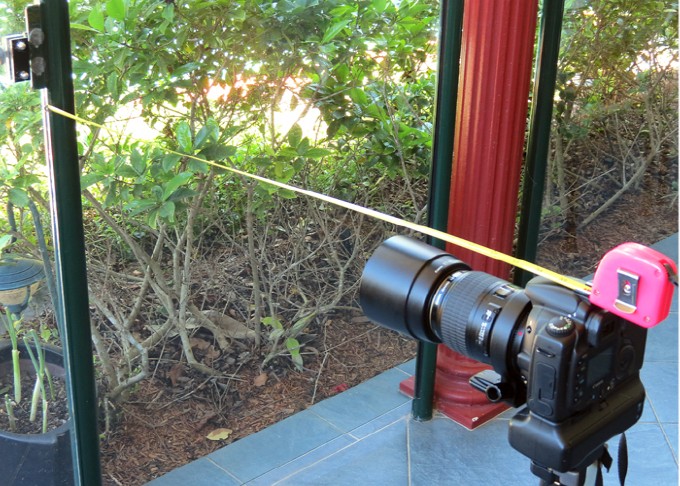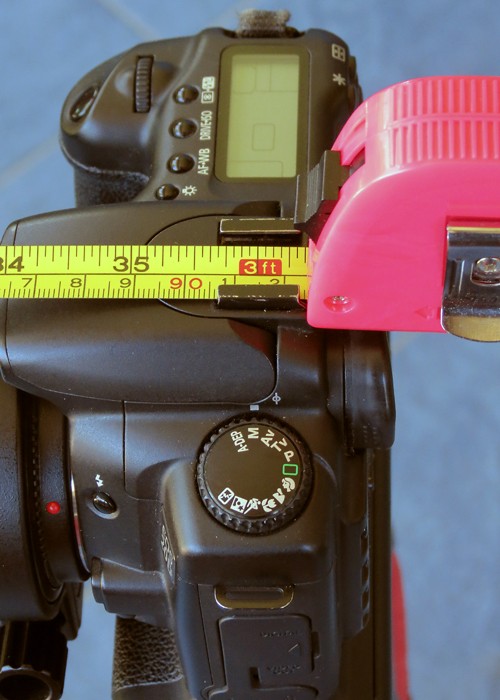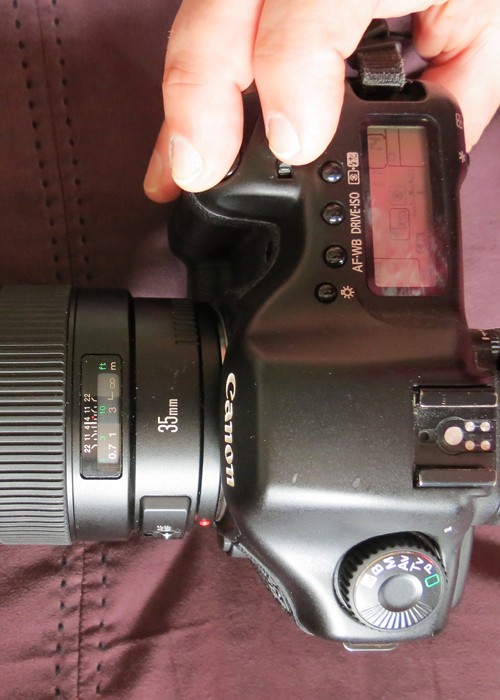I have a question regarding the focus gauge that some lenses have. If I focus on an object, either auto focus or manual focus, and read the gauge on the lens, it always reads less than the actual distance between the camera and the object. For example, I have tried this with a Tamron 90mm macro, which has very sharp focus, and focused on a wall 10 feet away and 30 feet away (by actual measurement) and then read the gauge on the lens, it indicates 7 feet and 15 feet respectively. I am not talking about the depth of field lines showing on the lens, but the actual distance. I have tried the same thing with two other lenses of different focal lengths and they all seem to indicate focus point at less than the actual distance. Anyone have an explanation? I had always thought that the reason for the scale was so that you could dial in the focus if you knew the distance and the camera would then be in focus. But if you do this the camera will reduce the distance if auto focus is then engaged. It seems that maybe the distance that the camera is focusing on is a hyperfocal point or something. I have tried this with a Sony SLT A33 (a newer digital camera and with an old Minolta X700 film camera and both give same result, so it does not seem to be a problem with a specific camera or a specific lens.
 Helpful Posts: 0
Helpful Posts: 0
Results 1 to 5 of 5
-
23rd February 2012, 11:45 PM #1New Member

- Join Date
- Feb 2012
- Location
- Pacific Northwest, USA
- Posts
- 6
- Real Name
- Paul Bowen
Question on the focus distance gauge on a lens
-
24th February 2012, 02:35 AM #2
Re: Question on the focus distance gauge on a lens
With that TAMRON Lens, the numeral “10” is reasonably wide and the space between “10” and “5” is reasonably small, so what part of the "10" is aligned to the mark and where does 7ft sit, are the questions.
Also, at that end of the focus turret, the movement (degree of turn) is minimal to make sharp focus.
Also for thsat tamron lens I do not believe that there are 30 ft nor 15 ft markings, so where do those two sit, between 10ft and ∞, when reading off the distance scale?
It is not mentioned what other lenses have been tested – but the markings on my lenses are pretty close - for what they are worth – taking into account and noting specifically that the most lenses these days (after Auto Focus arrived) have a very small rotational turn of the focus turret from Min Focus to ∞
It would be better testing that macro lens at closer targets, where the increments on the focus turret are more meaningful.
EG - for a similar Macro Lens (EF 100F/2.8)
Choose a distance that is easy to read and easy to align on the Focus Turret - in this case I chose 3ft.

Set the tripod such that Camera’s Focal Plane is at 3ft and also set Camera square to the target, in all aspects.

Use Manual Focus to adjust the Lens to Sharp Focus on target.
Read off the distance scale:

The green "3", indicating 3 ft seems aligned with the marker.
***
Are you sure that you are measuring to the Focal Plane of the Camera?
WWLast edited by William W; 24th February 2012 at 03:32 AM. Reason: Added the Question to the OP
-
24th February 2012, 06:59 AM #3New Member

- Join Date
- Feb 2012
- Location
- Pacific Northwest, USA
- Posts
- 6
- Real Name
- Paul Bowen
Re: Question on the focus distance gauge on a lens
Thanks for going to the trouble to check it with your camera/lens. I did get some more input and believe I have solved the problem.
I posed the same question to Tamron and they provided a very long and technical answer that I want try to repeat entirely, but basically the problem is that the scale becomes less accurate the farther the focus distance.
This was evident in my case with the 30 ft distance being more in error than the 15 ft distance. As per Tamron, this is partially due to the short throw of the focus ring with the distance scale being logarithmic and markings getting closer together and partially due to the advent of auto-focus lenses. Old manual focus lens actually stopped at infinity and could be set at infinity manually. To prevent the focusing mechanics from "slamming" into the end, AF lens can usually focus past infinity. Therefore, the infinity marking and the adjacent distance marks are not accurately marked on the lens. Not sure if I have explained it clearly, but suffice to say, that at least my belief for all of these years was correct in that the distance is intended to represent the distance from the film/sensor to the subject if the lens is focused properly. It is just that the accuracy of the scale beyond 10 or 15 feet tends to be more approximate in the case of auto-focus lens. To check this, I did find that my old Minolta MC/MD mount lens were much more accurate beyond 15 feet than my various AF lens. In the old days, guessing at the distance and setting the focus at that distance was a quick and dirty way to grab a quick shot, particularly in low light situations. Now with AF and high ISO sensors, the situation does not come up as much. The reason the question came up was while shooting BIF, I found guessing the distance and pre-setting the focus manually worked better than trying to track and use continuous AF. In the process, I paced off the distance from a blind to a eagle nest tree and that is when I discovered the discrepancy due to out-of-focus shots. The solution of course is to simply pre-focus on the nest and forget the distance scale on the lens.
-
24th February 2012, 05:56 PM #4
Re: Question on the focus distance gauge on a lens
Some time ago I have checked like in William's message shown, what numbers on the ring really mean.
In case of Canon EF 28-70 mm 1:2.8 that was distance from the object to the mount of lens + up to about 1.5 cm deep into camera body depending on the focal length (!). Don't remember exactly.
But that was not the distance to the focal (film) plane at all:
http://software.canon-europe.com/fil...Book_10_EN.pdf

Last edited by darekk; 24th February 2012 at 06:04 PM.
-
26th February 2012, 01:20 AM #5
Re: Question on the focus distance gauge on a lens
Hi darekk,
I am not exactly sure what you are getting at with the illustration: but the Distance Markings on the Lens’s Focus Turret are indicative of the Subject Distance (SD).
In the illustration you provided above, Canon (and others also) refer this "Subject Distance" as the Shooting Distance.. But many folk like to avoid the phrase, "Shooting Distance", because it can cause confusion when we get into the world of Macro-Photography, especially when we refer to "Working Distance", but that is another topic.
In the discussion here the SD is indeed measured from a point INSIDE the camera, to the Subject.
In old text books, the “Subject Distance” were actually referred to as "the Camera to Subject Distance" , (note the use of the word "Camera", not "Lens").
The diagram which is supplied above, is an out of proportion side section view showing the Subject; The Lens and also the inside of the Camera.
In the diagram the Subject Distance = R; which is measured from points indicated at the Subject which is measured as y, to the Inverted Image of the Subject, which is measured as y1.
So therefore the THICK INVERTED ARROW (Image of the Subject) measured as y1, occurs at the Focal Plane of the Camera.
***
I believe I might have made some confusion, because I used the term “Focal Plane of the Camera”:
This is traditionally (perhaps still correctly) referred to as the Film Plane of the Camera.
But with the overwhelming use of Digital cameras in the past 10 years, there has been a tendency in some circles, including teaching, to refer to the “Film Plane” as the “Sensor Plane”.
But, also there has been an equal tendency to also use ONE term which fits both “Sensor” and “Film” and that is Focal Plane (of the Camera) – this term also keep the same initials “FP” as the old “Film Plane” and the addition words “of the Camera” make it clear that the phrase is referring to something inside the Camera.
The Film Plane, Sensor Plane, and Focal Plane of the Camera; are all terms referring to the same Plane, inside the camera and this is the Plane from which the SD – Subject Distance – or – Shooting Distance – is measured.
The Film / Sensor / Focal Plane which is located inside the camera is represented by the Greek Letter phi - ɸ - and the bar is at the Line of the Plane.
This ɸ marker can be seen clearly in my second image and that is why the tape measures at 3ft, above that marker.
***
Hi Paul,
I am not entirely sure that with the explanation you received from TAMRON might be the whole story as I think that there is a little extrapolation of non-fact on one point.
Certainly the modern lenses have a comparatively very short travel across the Focus range, but many lenses are made such that they focus beyond ∞ so that the can accommodate Infra Red Photography, which actually requires shifts a focus shift of the lens: and considerably so at, ∞.
So in this regard to this point I am not so sure that the lens extends beyond focus at infinity so the AF motor doesn’t slam into the buffer stop – but it was certainly interesting reading that this was TAMRON’s explanation –this now will be one of those little trivial pursuit questions I shall keep the back of my mind to seek further clarity upon.
As you mentioned Old Minolta lenses, as you mentioned, those Old Minolta lenses have a lot more travel around the lens turret – hence all the calibrations will be more accurately indicated and not just at the greater distances.
Those lenses’ distances too are logarithmic in gradation – it is just that there is more of the focus turret around which, the markings are spread hence all the markings are more accurately read.
***
Certainly, I still use the Distance Markings on modern (Canon) lenses, specifically the 24 and 35 (and sometimes the 50). In these cases it is for the purpose of Hip Shooting or Hail Mary Shooting and typically the Distance Dial is used to set adequate range such as here using the 35, where the expectation of Subject Distance is at about 1.8~2.4mtrs (6ft ~ 8ft) – AND - F/11 is selected usually in Av Camera Mode such that I am safe across a reasonable DoF when not using the viewfinder to frame and therefore, dangerous to rely on AF.
This example is indicated by referring to the Lens’s Distance Markings in this image at the two F/11 Markings showing bthta I am pretty safe for DoF at about the 6ft to 8ft range if I use F/11 :

Possibly these almost now obsolete shooting techniques (Hip Shooting and Doorstop hail Mary Shooting), are now the only useful purpose for the modern, AF Lens’s Distance Markings on their Focus Turrets.
And I also note that many (most?) (younger?) Press Photographers use AF when shooting Hail Mary: perhaps relying upon the Photographers' ability to aim accurately at the target or the camera's ability to assume correctly the main target and keep that target within the selected AF points - I am not so sure though, that automation in this case always out-weighs the older methods.
WW


 Reply With Quote
Reply With Quote

